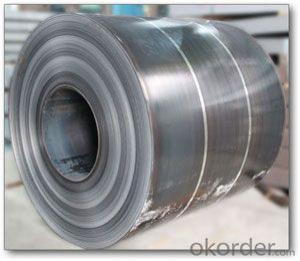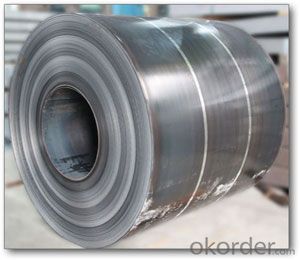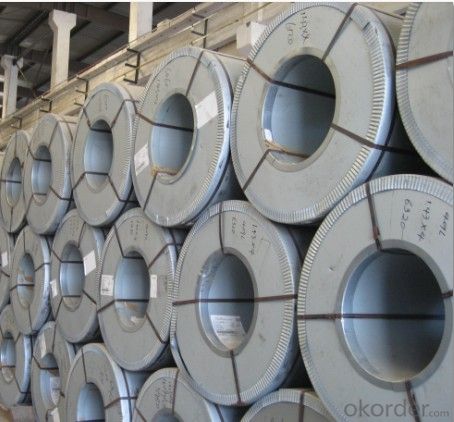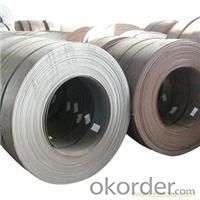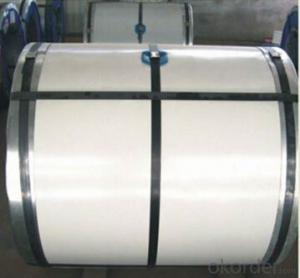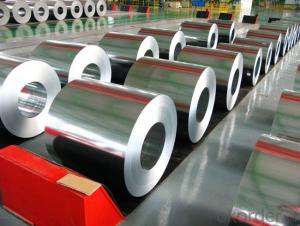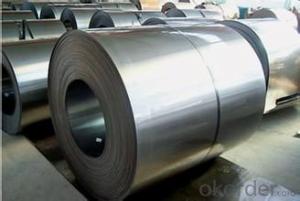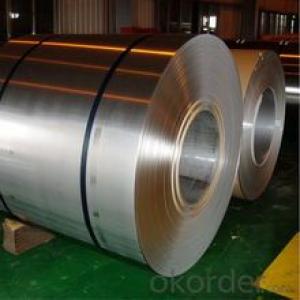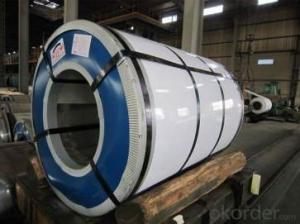HOT-ROLLED STEEL COIL NO.1
- Loading Port:
- China Main Port
- Payment Terms:
- TT OR LC
- Min Order Qty:
- -
- Supply Capability:
- -
OKorder Service Pledge
OKorder Financial Service
You Might Also Like
HOT-ROLLED STEEL COIL
Hot rolled low hardness, easy processing, good ductility.
Available specification:
| thickness | width(mm) | length(mm) | coil inside diameter(mm) |
HOT ROLLED STEEL COIL | 1.5-25 | 600-2000 |
| 762 |
HOT ROLLED STEEL STRIP | 1.5-20 | 30-720 |
| 762 |
HOT ROLLED STEEL PLATE | 6-700 | 500-4500 | 4000-18000 |
|
HOT ROLLED STEELSHEET | 1.2-25 | 50-2000 | 0-18000 |
|
We can supply customers' with different specifications of the highest quality and lowest price.
Sincerely welcome to contact us for the future details if any item interest you ,and we will make every effort to assure that your requirements will be satisfied ,and we hope to establish long-term business relations with you on the basis of the equality and mutual benefit.
We are waiting for your email.
- Q: If you combine stainless steel with gold, does that make stainless gold?
- Stainless steel, I believe, was an actual trade name of a british cutlery company's knives, once the ability to create iron-chromium alloys was mastered. Stainless steel's main alloying agent that prevents it from rusting, is Chromium. The Chromium in the steel creates an protective layer (not unlike rust), which acts as a protectant for the rust-prone iron...keeping real rust away. I am no metallurgist, but I have not heard of gold being used as an alloying agent in common steels. I'm not even sure they would mix. Not all metals can be stirred together successfully. Even if gold could be used as an alloying agent for steel, it would need to be in such a small percentage, you would not end up with a metal that was gold in appearance...so it would still look like steel of some sort. The funny part is, gold is already stainless, and does not tarnish or rust as it is.
- Q: What are the different types of steel coil treatments?
- There are several different types of steel coil treatments that are used to enhance the properties and performance of steel coils. These treatments include: 1. Annealing: Annealing is a heat treatment process that involves heating the steel coil to a specific temperature and then slowly cooling it. This treatment helps to relieve internal stresses, improve ductility, and increase the overall strength of the steel coil. 2. Pickling: Pickling is a chemical treatment that involves immersing the steel coil in a solution of acid or other chemicals to remove impurities, scale, and rust from the surface. This treatment helps to improve the surface finish and cleanliness of the steel coil. 3. Oil coating: Oil coating is a treatment that involves applying a thin layer of oil or other protective coating to the surface of the steel coil. This treatment helps to prevent corrosion, improve lubricity, and protect the steel coil during storage and transportation. 4. Galvanizing: Galvanizing is a process that involves coating the steel coil with a layer of zinc to protect it from corrosion. This treatment creates a barrier between the steel coil and the surrounding environment, ensuring long-term durability and resistance to rust. 5. Tempering: Tempering is a heat treatment process that involves heating the steel coil to a specific temperature and then rapidly cooling it. This treatment helps to improve the toughness and strength of the steel coil, making it more resistant to impact and deformation. These are just a few examples of the different types of steel coil treatments that are commonly used. Each treatment has its own specific purpose and benefits, and the choice of treatment will depend on the desired properties and application of the steel coil.
- Q: How do steel coils perform in extreme weather conditions?
- Steel coils generally perform well in extreme weather conditions. Steel is a durable and strong material that can withstand high temperatures, extreme cold, and harsh weather elements such as rain, snow, and wind. It has excellent resistance to corrosion, making it suitable for various outdoor applications. However, it is important to note that the performance of steel coils can vary depending on factors such as the specific grade of steel used, protective coatings applied, and the maintenance and care provided.
- Q: What are the main factors to consider when selecting a steel coil supplier?
- When selecting a steel coil supplier, the main factors to consider include the supplier's reputation and reliability, the quality of their products, their pricing and payment terms, their delivery options and lead times, their customer service and support, as well as their ability to meet your specific requirements and specifications.
- Q: How are steel coils processed for stamping or forming?
- Steel coils are processed for stamping or forming through a series of steps. First, the coils are uncoiled and straightened to remove any bends or twists. Then, they are fed into a stamping or forming machine, where the desired shape or pattern is formed by applying pressure. After the stamping or forming process, the excess material is trimmed or cut off, and the finished parts are inspected for quality.
- Q: I moved into a house which has a steel front door.When I touch the door it feels very cold to the touch in the winter.There is a storm door also and the weather stripping looks good.Cold air from the door is entering the lower level.The house is about 20 yrs old.
- Not all steel doors are. Its about 20* where i am and my steel door feel somewhat cold, but not very cold. Yours could not be? If you take the lock off the door and look inside the hole where the lock was you should see insulation inside your door.
- Q: What are the common coil sizes available for steel coils?
- The common coil sizes available for steel coils vary depending on the specific industry and application. However, there are several standard coil sizes that are commonly used across different sectors. These include 36-inch, 48-inch, 60-inch, and 72-inch coil widths. In terms of coil diameter, the most common sizes are typically between 20 inches and 24 inches. Additionally, coil weights can range from a few thousand pounds to several tens of thousands of pounds, depending on the type of steel being coiled and the intended use. It is important to note that these sizes may vary among different steel manufacturers, so it is always advisable to consult the specific supplier or industry standards to determine the available coil sizes for a particular steel product.
- Q: How do steel coils contribute to energy savings in buildings?
- Steel coils contribute to energy savings in buildings in several ways. Firstly, steel coils are often used as part of the insulation system in buildings. The high thermal conductivity of steel allows for efficient heat transfer, ensuring that the building remains well-insulated and energy loss is minimized. Additionally, steel coils are often used for HVAC systems, which play a crucial role in energy efficiency. By using steel coils in these systems, the heat transfer process can be optimized, reducing the energy required to heat or cool the building. Moreover, steel coils are durable and long-lasting, reducing the need for frequent replacements and maintenance, which in turn saves energy and resources. Overall, the use of steel coils in buildings helps to improve energy efficiency and reduce energy consumption, contributing to significant energy savings.
- Q: What are the common sizes of steel coils?
- The specific needs and requirements of different industries determine the variations in common sizes of steel coils. However, the steel manufacturing and processing sectors commonly utilize standard sizes. These sizes include: 1. Slit Coils: Typically smaller, slit coils are readily available in widths ranging from 0.5 inches to 72 inches. The weight of slit coils varies, usually falling between 1000 pounds and 50,000 pounds. 2. Master Coils: Larger in size, master coils are generally utilized in steel processing facilities for the production of different steel products. The width of master coils commonly ranges from 36 inches to 96 inches, while the weight may vary from 5,000 pounds to 60,000 pounds. 3. Sheet Coils: Construction, automotive, and appliance manufacturing industries often employ sheet coils. The standard sizes for sheet coils vary, but they are commonly found in widths of 48 inches, 60 inches, and 72 inches, with lengths ranging from 96 inches to 240 inches. 4. Plate Coils: Primarily utilized in heavy-duty applications such as shipbuilding, bridge construction, and pressure vessel manufacturing, plate coils tend to be larger in size. Their widths typically range from 36 inches to 96 inches, while lengths vary from 96 inches to 480 inches. It is important to note that these sizes are not fixed and can be customized according to specific customer requirements. Steel manufacturers and suppliers possess the capability to produce coils in various sizes to cater to the diverse needs of their clients.
- Q: How are steel coils inspected for quality control purposes?
- Steel coils are inspected for quality control purposes through a combination of visual inspection, dimensional measurements, and various non-destructive testing techniques. This includes checking for surface defects, such as scratches or dents, as well as verifying the dimensions, weight, and shape of the coils. Additionally, technologies like ultrasonic testing, magnetic particle inspection, and X-ray examination are employed to detect internal defects, such as cracks or inclusions, ensuring that the steel coils meet the required quality standards.
Send your message to us
HOT-ROLLED STEEL COIL NO.1
- Loading Port:
- China Main Port
- Payment Terms:
- TT OR LC
- Min Order Qty:
- -
- Supply Capability:
- -
OKorder Service Pledge
OKorder Financial Service
Similar products
Hot products
Hot Searches
Related keywords
